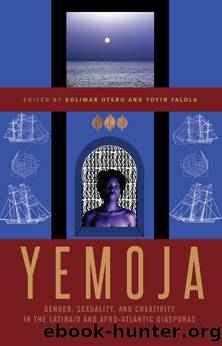Yemoja by Solimar Otero Toyin Falola

Author:Solimar Otero, Toyin Falola [Solimar Otero, Toyin Falola]
Language: eng
Format: epub
ISBN: 9781438448015
Barnesnoble:
Publisher: State University of New York Press
Published: 2013-11-01T00:00:00+00:00
Chapter 5
Yemoja
An Introduction to the Divine Mother and Water Goddess
Allison P. Sellers
Yemoja is a river and ocean goddess of the òrìsà spiritual tradition practiced by the Yorùbá of West Africa and their descendants across the Atlantic. Once deconstructed, her name in Yorùbá means âMother of Fish.â1 Worshipers also call her by other names, all derivatives of Yemoja2âYemaja,3 Yemonja,4 and Yemanja5 in West Africa and the Americas; Yemayá6 in Cuba; and Emanje7 in Trinidad.8 Like other deities whose worship crosses oceans and continents, Yemojaâs traditions have shifted over time in response to the needs of her followers. However, discrepancies in her mythology and adjustments in religious practices associated with her have not altered the fundamental aspects of her role among the Yorùbá. She is first and foremost their mother goddess, and òrìsà practitioners in West Africa and the Americas consistently turn to her when seeking fertility, good health, and abundance in general. In this chapter, I will examine Yemojaâs position in the Yorùbá pantheon and her evolution as she crossed the Atlantic. Synthesizing the contributions of scholars such as A. B. Ellis, Ulli Beier, William Bascom, Babatunde Lawal, and Lydia Cabrera, my goal is to provide a comprehensive (if not exhaustive) analysis of Yemojaâs nature, her place in the òrìsà tradition, and her significance among the Yorùbá and their descendants in the Americas.
In West Africa, òrìsà number in the hundredsâthe estimate most often agreed to is four hundred.9 Some of these deities are ubiquitously acknowledged and honored in Yorùbá culture, while many are unique to certain regions and might even be worshipped in just one village. In the Americas, the number of òrìsà reduces dramatically to just a few dozen of the most powerful and culturally significant.10 They are divided into two groups: âhotâ and âcool.â The âhotâ òrìsà , such as Sà ngó and Ãgún, are known to be temperamental and fierce, while the âcoolâ òrìsà are milder and more stable. Yemoja belongs to this latter group,11 the òrìsà funfun (âwhite deitiesâ).12 These hot and cool forces are complimentary, and likewise hot and cool òrìsà balance each other. For example, at the end of a Sà ngó festival, worshipers sometimes sing a praise song to Yemoja, whose cooling effects are supposed to ensure that the ritual proceedings do not get overheated due to their focus on Sà ngó.13 When referring to individuals, the concept of coolness in Yorùbá culture translates to composure. The ability to remain stoic when excitement and sentimentality would be appropriateâwhether in a positive or negative contextâis considered both admirable and attractive. In terms of the community, coolness is understood as stability.14 Worshipers often call upon the òrìsà funfun specifically to bring their cooling effects in times of turmoil and to reinforce peace and cohesion.
Download
This site does not store any files on its server. We only index and link to content provided by other sites. Please contact the content providers to delete copyright contents if any and email us, we'll remove relevant links or contents immediately.
Kathy Andrews Collection by Kathy Andrews(10519)
The remains of the day by Kazuo Ishiguro(7551)
Spare by Prince Harry The Duke of Sussex(4195)
Paper Towns by Green John(4169)
The Body: A Guide for Occupants by Bill Bryson(3801)
Be in a Treehouse by Pete Nelson(3212)
Harry Potter and the Goblet Of Fire by J.K. Rowling(3045)
Goodbye Paradise(2962)
Never by Ken Follett(2880)
Into Thin Air by Jon Krakauer(2701)
The Remains of the Day by Kazuo Ishiguro(2618)
The Genius of Japanese Carpentry by Azby Brown(2609)
The Cellar by Natasha Preston(2595)
Drawing Shortcuts: Developing Quick Drawing Skills Using Today's Technology by Leggitt Jim(2532)
120 Days of Sodom by Marquis de Sade(2437)
Architecture 101 by Nicole Bridge(2350)
The Man Who Died Twice by Richard Osman(2298)
Machine Learning at Scale with H2O by Gregory Keys | David Whiting(2290)
Fairy Tale by Stephen King(2069)
